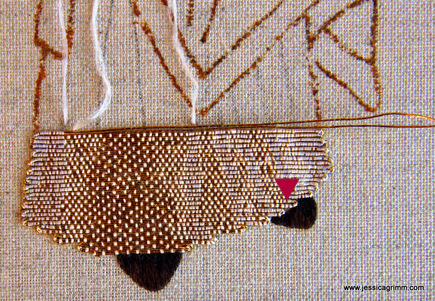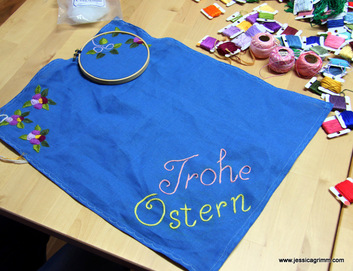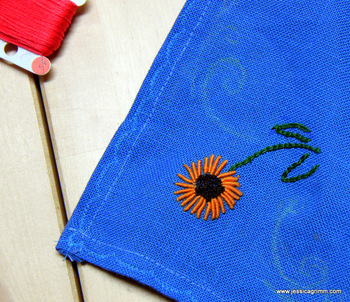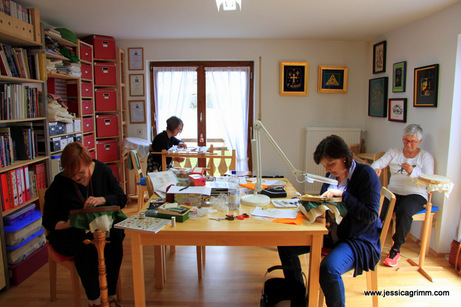|
As several people have enquired after Laurence, I figured that I should make him the star of this week's blog post. Do you think a saint from the Roman period should get media training first before he makes an online appearance? After previously stitching his feet with Chinese flat silk, I've now made a start on his alb. An alb is worn by clergy under other garments such as the dalmatic or chasuble. As the Christian faith developed during the Roman Empire, many of its organisational structure and costumes are Roman. The alb, from the latin albus, meaning white, is a Roman tunica. Laurence's alb is stitched in or nue technique. Which means that, in this case, Japanese Thread #8 is covered by couching stitches of Chinese flat silk in two off-white tones. To give the impression of folds, the couching stitches are placed closer together or spaced out. It is not unlike silk shading or black work as taught at the Royal School or Needlework. As you can see, I have several needles on the go at the same time. Not bad for a first attempt. See the pink arrow in the picture above? There is a little bit of fabric showing between the alb en Laurence's left shoe. I'll mend that with a few extra stitches. And make a mental note to self that in the future I should go over the design line when working such areas. Oh, and just as modern gold embroiderers, our medieval counterparts didn't like plunging. So they just didn't. Really, they didn't! They just couched the thread till the desired design line and then snipped it off. As a good Royal School of Needlework girl, I was a little sceptical at that. However, no guts no glory. Below the pink arrow in the above picture, you see the tails of my old threads and the tails of my new threads. I ignored the fact that they are tails and just couched over them as my design required. I took the picture just before I snipped the tails off. Laurence has been brave too; after snipping he was still fine... And this is what Laurence looks like after 16 hours of stitching. I made a start on his green cloth of gold dalmatic with the red trim. Past and future blog posts on this project can be easily found by selecting 'St Laurence' in the category list to the right of this post.
7 Comments
Many of you know that I started a weekly embroidery afternoon class for the refugee women in our village late last year. We have been meeting more or less regularly, depending on my workload, for the past few months. It soon turned out that embroidery, or indeed crafts, wasn't an option for all of them. Why make 'superfluous stuff' when you have been in survival mode for most of your life? For me, it was especially hard to connect to the African ladies. My super-efficient organised analytical mind does not seem to go well with the African way of life. That says more about my limitations than about the African way of life. And sorry for grouping a whole continent together too. And here are my lovely ladies: Tetyana from Ukraine, Rushda from Pakistan and Segal from Somalia. When you look closely, you can see that I myself have made integration progress too. Yes, after years of living on and off in Germany and England, I have finally understood the benefits of windows with curtains. No small feat for the Dutch, I tell you! Thanks to some very generous gifts from some of you, my ladies are all working on their own projects. Let me show you what they have been stitching. Tetyana has been an avid stitcher all her life, although being a chemistry teacher and mum of twin daughters did not leave her with a lot of spare time on her hands. She works on an Easter placemat. Easter? Yes, lucky Tetyana celebrates Easter in early May with the rest of the Eastern Orthodox Church. Plenty of time left to finish on time! Rushda has the advantage of being fluent in English. She loves to peruse my extensive embroidery library. And she loves bullion knots. She is the queen of bullion knots! Don't her sunflowers look pretty? It is not easy for her to leave the house on her own as that is not accepted social behaviour for a decent woman in Pakistan. With two young children to care for, she finds little time to stitch. We are now trying to find a second-hand playpen so that her one-year old son can safely play in my studio when mum is stitching. After all, scissors and needles are pretty dangerous. And last but not least, Segal, a teen from Somalia. Definitely a country you do not want to live born a woman. She wants to tell us so much about her life, but is handicapped by our limited understanding of Somali. I am especially happy that she has returned to my class. And that we have found something she loves to do and excels in. Last week, she started to draw traditional Somali floral patterns and copied them onto fabric. Can't wait to see them full-colour in thread. And in between the stitching we talk a lot about our former lives and the differences to our lives here in Germany. We eat cookies. Very important. And we sip a nice cuppa. Integration is fun.
Last week, I was joined by two German and two Swiss ladies for a five-day goldwork embroidery course. Note: I no longer offer this course. Up to five students fit into my spacious light flooded studio. As a five-day course can be quite intensive, we'll break regularly for coffee/tea and we'll enjoy an excellent lunch together. Meeting like-minded embroidery enthusiast in a friendly place where you are well taken care off; who doesn't want that? Bad Bayersoien has plenty of good and affordable accommodation to make the week into a needlework retreat with time left to explore the beautiful alpine landscape. Hazel Everett's book on Goldwork proved to be the right sort of inspiration for two of my ladies. Remember the leaf sampler from the book? Instead of working the same leaf, a series of different shaped leaves was filled with a myriad of goldwork techniques. Not too keen on gold-gold? Then silver might be the answer. And who doesn't remember the bug pages from Hazel's book? It was such fun to see bug after bug emerge under Monika's skilful hands. One of the ladies was taken by my Celtic knot, so we searched for a similar design in the book 'Armenian ornamental Art'. Mirrored, the end-knot on a cross became the right sort of design with plenty of scope to practise couching different goldthreads, chipping and cutwork. Rita came up with a design all her own. She started work on a house blessing for friends based on the Magi. She incorporated several materials she had acquired over the years. It has been a lot of fun to guide my ladies during their different projects. However, the past few weeks have been really busy. So, as the weather is really nice in this part of the world, I done my walking boots and take a well-deserved break. A refreshed me will see you next week.
|
Want to keep up with my embroidery adventures? Sign up for my weekly Newsletter to get notified of new blogs, courses and workshops!
Liked my blog? Please consider making a donation or becoming a Patron so that I can keep up the good work and my blog ad-free!
Categories
All
Archives
July 2024
|
Contact: info(at)jessicagrimm.com
Copyright Dr Jessica M. Grimm - Mandlweg 3, 82488 Ettal, Deutschland - +49(0)8822 2782219 (Monday, Tuesday, Friday & Saturday 9.00-17.00 CET)
Impressum - Legal Notice - Datenschutzerklärung - Privacy Policy - Webshop ABG - Widerrufsrecht - Disclaimer
Copyright Dr Jessica M. Grimm - Mandlweg 3, 82488 Ettal, Deutschland - +49(0)8822 2782219 (Monday, Tuesday, Friday & Saturday 9.00-17.00 CET)
Impressum - Legal Notice - Datenschutzerklärung - Privacy Policy - Webshop ABG - Widerrufsrecht - Disclaimer



















 RSS Feed
RSS Feed